Posted by Anita on 01.03.09 7:53 PM
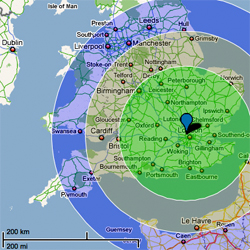 When you live on an island that’s a mere 300 miles wide, local food is a relative thing. In the map to the left, the blue pin shows the location of our London flat. The green circle — which touches the Normandy coast of France — shows a 100-mile radius; yellow encompasses 150 miles, and blue — which grazes Paris! — illustrates the 200-mile radius that many wintertime eat-local challenges allow.
When you live on an island that’s a mere 300 miles wide, local food is a relative thing. In the map to the left, the blue pin shows the location of our London flat. The green circle — which touches the Normandy coast of France — shows a 100-mile radius; yellow encompasses 150 miles, and blue — which grazes Paris! — illustrates the 200-mile radius that many wintertime eat-local challenges allow.
Looks like it would be easy to eat local, doesn’t it? I’m sure with a little practice and a bit of hunting, it definitely could be. But when you’re on holiday and have no understanding of where cities, counties, and postcodes are situated within Britain, it’s definitely a challenge. And when we discovered that most of London’s farmers markets run on a reduced schedule and roster for the run-up to Christmas, we thought we might have to call a vacation hiatus on making our weekly Dark Days meal from all-local ingredients.
Our biggest shock came on an afternoon trip to the world-famous Borough Market, the place we assumed would be the highlight of our shopping excursions. But although it’s still a feast for the eyes, it’s definitely taken on a more-corporate feeling since our last visit. And despite the wealth of delectables on offer, we found it nearly impossible to unearth items grown or produced local to London. One very pleasant exception: Mrs King’s gorgeous raised-crust pork pies are made in the appellation-controlled region of Melton Mowbray, about 90 miles from London.
Most of the bread we found, at Borough and in shops, was baked either on the outskirts of London, or in nearby Oxfordshire. Once we got a little basic geography under our belts, finding local ales and ciders was easy-peasy, even in the big supermarkets. And many well-regarded packaged products — preserves, pickles, mustards, crackers, cookies, and so forth — are made in Britain, if not within southern England per se.
 If you’re willing to leave the foodie haunts and supermarkets behind, the news gets better. FARMA-certified London Farmers’ Markets have some of the most thorough guidelines I’ve ever seen, touching on everything from permissible ingredients in artisan goods to animal welfare to to maximum distances traveled: Everything sold must be “raised, grown, produced, gathered, caught, or baked within 100 miles of the M25”, London’s exterior beltway. Even on a very slow week at the Marylebone Farmers Market, we were able to cobble together a full meal: Sausages (produced on Food Fore Thought‘s East Sussex farm, using their own-raised pork), Brussels sprouts, and potatoes, which we served with a store-bought bottle of real ale from Hook Norton in Oxfordshire, 81 miles from London.
If you’re willing to leave the foodie haunts and supermarkets behind, the news gets better. FARMA-certified London Farmers’ Markets have some of the most thorough guidelines I’ve ever seen, touching on everything from permissible ingredients in artisan goods to animal welfare to to maximum distances traveled: Everything sold must be “raised, grown, produced, gathered, caught, or baked within 100 miles of the M25”, London’s exterior beltway. Even on a very slow week at the Marylebone Farmers Market, we were able to cobble together a full meal: Sausages (produced on Food Fore Thought‘s East Sussex farm, using their own-raised pork), Brussels sprouts, and potatoes, which we served with a store-bought bottle of real ale from Hook Norton in Oxfordshire, 81 miles from London.
And in the world beyond all-local, the news is better still. Even in mainstream supermarkets like Waitrose and Sainsbury’s, it’s easy to find cage-free eggs and pastured chickens; a solid majority of carton eggs sold in the UK are cage-free. Thanks to many campaigns by celebrity chefs like Jamie Oliver and Hugh Fearnley-Whittingstall, Britons are by now far more aware of the intrinsic cruelty of the battery hen system than the average consumer here at home. And in England, organic certification — the kind you see stamped on supermarket chickens — means more. It’s not just a simple matter of feeding Chinese organic soy to your animals; the Soil Association (Britain’s main certification agency) guidelines call not just for a cage-free environment, but true “freedom to range”.
Lest you think this means a giant warehouse with a tiny door to a barren yard, the guidelines actually stipulate that birds may not even be permanently housed, and that their forage must be “well-covered with suitable vegetation”. And SA-certified poultry isn’t just something you’ll find in posh shops: Even on the New Year’s Day bank holiday, we had no trouble finding SA-certified organic chicken parts in a ‘Sainsbury Local’, a neighborhood grocery the size of a 7-11. We couldn’t find any evidence that this meat was local to us, but it was labeled “product of Britain”, as were many meat packages we saw and bought.
Despite handicaps of seasonality and familiarity, I feel like we were able to do quite well, rather easily. It’s hard to ignore the feeling that it feels easier to put together an ethical and reasonably environmentally sensitive meal in London than in nearly any other large city we’ve visited.

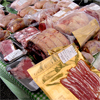

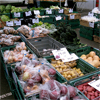

Dark Days challenge, farmers markets, locavore, London
4 Comments »




Posted by Anita on 12.28.08 6:34 AM
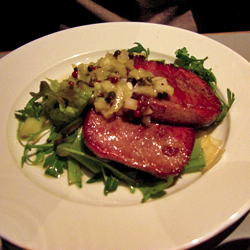 Even in the foodie heaven that is San Francisco, there’s no place like Konstam at the Prince Albert. A Victorian pub that’s been converted to a high-design jewelbox restaurant — it would take an entire paragraph just to explain the chandeliers-slash-draperies — Konstam toes the eat-local line with none of the obfuscation inherent in the standard “….whenever possible” disclaimer of Bay Area menus.
Even in the foodie heaven that is San Francisco, there’s no place like Konstam at the Prince Albert. A Victorian pub that’s been converted to a high-design jewelbox restaurant — it would take an entire paragraph just to explain the chandeliers-slash-draperies — Konstam toes the eat-local line with none of the obfuscation inherent in the standard “….whenever possible” disclaimer of Bay Area menus.
Even more impressively, Konstam’s sourcing radius is dramatically smaller than the usual 100-mile American definition: 85% of the kitchen’s ingredients, including flour and protein, come from the area covered by the London Underground and/or bounded by the M25 beltway, depending on where you’re reading. Either way, we’re talking about more or less 25 miles from central London.
One more thing: It seems that the idea to source ingredients locally was written into the restaurant’s plan before Chef Oliver Rowe really knew it was possible — but after a television deal had been signed. As a result, his tiny temple to seasonal and local food was well-known to British foodies even before the first meal was served. A two-week BBC miniseries called The Urban Chef documented the trials and tribulations of opening Konstam and finding suppliers. Watching video of Chef Rowe scouring the outer reaches of London feels like nothing so much as a giant, £300,000 dare… with the entire country watching each night on the telly.
 But enough about the schtick: How’s the food? Rowe wisely chose Northern and Central Europe as his inspiration, so even in the dead of an English winter, there’s sense to be made of the menu. A bowl of celeriac and apple soup came scattered with abundant hazelnuts, chunks of blue cheese, and a sprinkling of dill; the portion was far too large for such a dense porridge, but the flavors were lovely. Cameron enjoyed a starter of grilled Sevenoaks ox tongue, perfectly buttery-soft but meaty, garnished with a piquant pickled peppercorn relish atop a slick leek salad. It’s hard to choose which of our mains was the winner: Cameron chose perfectly charcoal-grilled leg of mutton, served with intensely vegetal chard and comforting colcannon. My own moan-inducing roast pork belly — complete with scored crispy crackling — came with both picture-perfect roast potatoes and a too-sweet cabbage compote.
But enough about the schtick: How’s the food? Rowe wisely chose Northern and Central Europe as his inspiration, so even in the dead of an English winter, there’s sense to be made of the menu. A bowl of celeriac and apple soup came scattered with abundant hazelnuts, chunks of blue cheese, and a sprinkling of dill; the portion was far too large for such a dense porridge, but the flavors were lovely. Cameron enjoyed a starter of grilled Sevenoaks ox tongue, perfectly buttery-soft but meaty, garnished with a piquant pickled peppercorn relish atop a slick leek salad. It’s hard to choose which of our mains was the winner: Cameron chose perfectly charcoal-grilled leg of mutton, served with intensely vegetal chard and comforting colcannon. My own moan-inducing roast pork belly — complete with scored crispy crackling — came with both picture-perfect roast potatoes and a too-sweet cabbage compote.
Although the wine list includes mostly Continental offerings, you can opt for a well-balanced choice of English wines from Kent, about 60 miles away, or pick from a great assortment of local ciders and ales from artisanal producers. We sampled the Sauvignon Blanc-like Chapel Down white and the funky Burrow Hill extra-dry cider; neither required the expected “pretty nice… for a local product” caveats.
Dessert was a modern take on traditional Victoria sponge — cake layered with cream and preserves — drizzled with vanilla syrup. Simple and exceedingly sweet, it would have been lovely with the espresso we ordered, but never received. And on that note: London will never be known for its stellar table service, but Konstam’s was even a step below the usual indifference. We were so happy with our food that we weren’t too troubled, but I can conjur a mood where we would have been furious at all the many issues with poor pacing, forgotten items, and long stretches of time where waitstaff simply disappeared — no mean feat in a restaurant the size of a large living room.
You could imagine Konstam being a worthwhile destination simply as a curiosity, a stunt-piece of a restaurant built on a conceit that might age poorly. But even without its locavore angle, the food delivers without offering (or requiring) any apologies for its constraints.
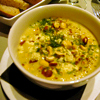
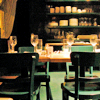
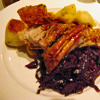


Konstam at the Prince Albert
2 Acton Street
London, WC1X 9NA
020 7833 5040
Dark Days challenge, locavore, London, restaurants
1 Comment »




Posted by Anita on 12.20.08 3:16 PM
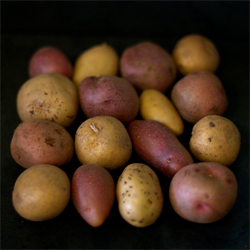 At our company Christmas party on Thursday night, the subject turned — as it often does in my culinary-obsessed office — to food. My boss’s husband asked me an interesting ice-breaker question: ‘What is your absolute favorite food?’
At our company Christmas party on Thursday night, the subject turned — as it often does in my culinary-obsessed office — to food. My boss’s husband asked me an interesting ice-breaker question: ‘What is your absolute favorite food?’
‘Easy,’ I replied immediately, ‘Potatoes, no questions asked.’
He was a little taken aback by my prompt reply; apparently, usually people hem and haw, then pick two or three favorites. But not me. I’m a potato girl to the end, and the only food that even comes close is pork. But it’s still second.
The quizzing continued, and I allowed as though I’d happily eat potatoes in any of their guises — boiled, hash-browned, french-fried, scalloped — but that my favorite-of-favorites had to be a big baked potato with butter and chives, salt & pepper.
About the only way I don’t like potatoes is the way they happen to be served at nearly every breakfast joint in San Francisco: Nominally home-fries, they’re irregularly shaped potatoes cooked on a giant flat-top griddle until they’re watery inside and burnt to a char on the out. They’re so universally terrible (and so terribly universal) that unless I know a restaurant serves shredded-style hash browns, I’ll ask for something else as a side-order substitute.
 Of course, any recipe with the word ‘home’ right in its name really begs to be made at one’s own stove, preferably while wearing pyjamas. And that’s just what I did when it came time to clean out the larder before our trip to London.
Of course, any recipe with the word ‘home’ right in its name really begs to be made at one’s own stove, preferably while wearing pyjamas. And that’s just what I did when it came time to clean out the larder before our trip to London.
We’d cider-brined a Range Brothers pork chop, and served it with O’Brien Potatoes, a sort of jumped-up version of home-fries recipe that, not-so-coincidentally, helped us use up a basket of new potatoes, a handful of tiny piquillo peppers, and a set of tiny onions, all in one fell swoop. Cameron seared the chop and then finished it in the oven, which gave him an excellent starting point for a sumptuous pan sauce (which used up the other half of the cider bottle, along with a little bit of chicken stock an a pat of butter. It was such a perfect accompaniment for the potatoes, they needed nothing more.
And as fridge clean-out meals go, it was a feast fit for a king.
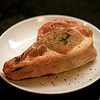
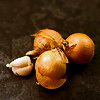
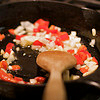

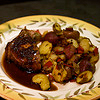
Potatoes O’Brien
12 to 16 baby potatoes
1 small onion, diced
2 piquillo peppers, or 1 small red bell pepper, diced
1 clove garlic, sliced
oil or bacon drippings
parsley, for garnish
Boil the potatoes until tender but still firm, a few minutes less than you would for potato salad. Meanwhile, saute the pepper and onion over medium-low heat in a wide skilled with sufficient oil or fat to soften well; back off on the heat if they begin to brown. When the potatoes are done, drain and rinse in cold water. As soon as they are cooled off enough to handle, slice into wedges or wide slices. Add the garlic to the saute mixture, and cook for 1-2 minutes to begin softening. Add the potato slices, and stir to coat; you may need to add more fat at this point if you weren’t generous with it at the beginning. Keep the heat on low, cooking the mixture together. Stir occasionally to check for sticking, but as little as possible to keep the potatoes intact and help with browning. When your main dish is almost ready, turn up the heat to medium or medium-high, and brown the potatoes to your liking, stirring once or twice to brown well on all sides. Season to taste with salt and pepper — if you used bacon fat, you won’t need much — and serve with sour cream, pan gravy, or ketchup.
Dark Days challenge, locavore
4 Comments »




Posted by Anita on 12.14.08 10:39 AM
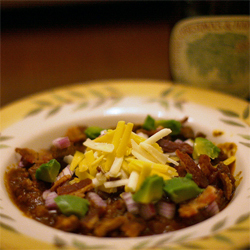 Between finishing up our Christmas shopping, getting our prize basket ready for Menu for Hope V, dealing with a rather scary veterinary emergency, and nailing down a few last details for our upcoming vacation, things have been a little chaotic around here. This morning as I sat down to write, I looked up in panic and realized that I had only photographed a single meal this week.
Between finishing up our Christmas shopping, getting our prize basket ready for Menu for Hope V, dealing with a rather scary veterinary emergency, and nailing down a few last details for our upcoming vacation, things have been a little chaotic around here. This morning as I sat down to write, I looked up in panic and realized that I had only photographed a single meal this week.
Luckily, it was our favorite chili, which — even though we eat it pretty much all the time — I’ve never blogged about. We love it because, unlike other chili recipes that we’ve been known to make, this one’s highly adaptable. Like our bolognese sauce and sloppy joes, it’s another one of the recipes that we make in giant batches and freeze for weeknight dinners. If we’re using it to make chilidogs — which we often do — we’ll leave the beans out and simmer it down until it’s all meaty and thick. If we’re eating it on its own, we’ll add some Rancho Gordo beans, and thin it down a little with a few cubes of frozen chicken stock.
We almost always garnish it with cheese, sour cream, and chopped onions, but if you happen to be lucky enough to have a strip of crispy bacon or a late-season avocado lurking in your fridge, either one makes a tasty and pretty addition. But this chili’s equally delicious when served all on its own, preferably with a pan of homemade cornbread and sweet butter. (We just discovered that Giustos, the local outfit that makes the all-purpose flour we buy, also sells locally milled cornmeal and polenta, which increases our Dark Days meal options significantly.)
 Adaptable Chili
Adaptable Chili
– loosely inspired by ‘Venison Chile with Red Beans’
from Staff Meals at Chanterelle
3 pounds stew meat, cut into 1/2-in inch cubes
(or substitute coarse-ground beef)
1 medium onion, diced
2 large cloves garlic, minces
1 tsp ground ancho chile
1 tsp ground pasilla chile
1 tsp Rancho Gordo ground red chile
1 tsp ground cumin
1 tsp ground cinnamon
1 tsp cayenne pepper
1/2 tsp black pepper
1/2 tsp dried thyme
1/2 tsp dried oregano
1/2 tsp cocoa powder
2 bay leaves
4 cups chicken stock or unsalted broth
1/2 cup tomato puree
2 cups cooked heirloom beans, drained (see note)
shredded cheese, sour cream, chopped onion, bacon, and/or diced avocado, for garnish
Pour vegetable oil to a depth of 1/8 inch into a large heavy Dutch oven set over medium-high heat. When the oil just begins to smoke, add only enough meat to cover the bottom of the pan without crowding. Brown well on all sides, turning with tongs. As the pieces brown, transfer to a bowl and continue with more meat in batches.
When meat is all browned, reduce heat to medium-low. Drain the accumulated oil from the bowl back into the pan; add the onion and garlic, and sweat until transluscent. Return the browned meat to the pan, then add the chile powders and spices. Stir well to coat the mat, then add the stock, tomato, and salt to taste. Bring to a boil, then reduce heat to low and simmer, uncovered, until the meat is tender — 2 to 2-1/2 hours — stirring occasionally. Stir in the beans, if using, and cook until heated through, about 5 minutes. Taste and adjust seasonings.
Note: If freezing for later use, the chili takes up less space without the beans, which you can always add the night you plan to serve it.
Dark Days challenge, locavore, recipes
8 Comments »




Posted by Anita on 12.07.08 2:26 PM
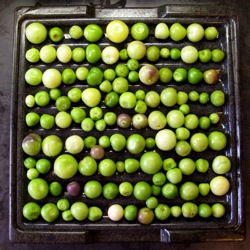 Last weekend, I went through both freezers — the little one in the kitchen, and the slightly larger one in the garage — and inventoried their contents. I didn’t discover any huge surprises in either location, thankfully, but I did turn up a few odds and ends that would be better to eat now rather than later. And since we needed to make room for half a turkey’s worth of meat, a little reorganization was in order.
Last weekend, I went through both freezers — the little one in the kitchen, and the slightly larger one in the garage — and inventoried their contents. I didn’t discover any huge surprises in either location, thankfully, but I did turn up a few odds and ends that would be better to eat now rather than later. And since we needed to make room for half a turkey’s worth of meat, a little reorganization was in order.
In addition to the pickles and broth I put up last weekend, I also made a big batch of tomatillo-sauce base to freeze: I roast and puree chiles and tomatillos, then add onions and simmer it down. Right before I’d usually add poultry broth and re-reduce to make a sauce, I cool down the paste and portion it out for the freezer. When I want to make enchiladas or chile verde, I thaw a brick, add the missing liquid, and finish the recipe.
 The two big Dark Days meals we cooked at home took care of some freezer odds and ends, and used the last of the un-frozen Thanksgiving leftovers, too. On Monday night, we whipped up a batch of our favorite stacked enchiladas with a little of the tomatillo sauce I’d set aside, along with a half-packet of tortillas and container of Rancho Gordo beans from the freezer, and the last bits of meat left over from turkey sandwiches. Later in the week, Cameron made a delicious beef-and-ale stew using a pound of Marin Sun chuck we’d stashed away from an early CSA box. Topped with the last of the Thanksgiving mashed potatoes, the stewmade a very decadent sort of cottage pie.
The two big Dark Days meals we cooked at home took care of some freezer odds and ends, and used the last of the un-frozen Thanksgiving leftovers, too. On Monday night, we whipped up a batch of our favorite stacked enchiladas with a little of the tomatillo sauce I’d set aside, along with a half-packet of tortillas and container of Rancho Gordo beans from the freezer, and the last bits of meat left over from turkey sandwiches. Later in the week, Cameron made a delicious beef-and-ale stew using a pound of Marin Sun chuck we’d stashed away from an early CSA box. Topped with the last of the Thanksgiving mashed potatoes, the stewmade a very decadent sort of cottage pie.
We spent some time this weekend getting the garden ready for fall, pruning the fruit trees and cutting back the hardy herbs like rosemary. I ended up with enough cuttings to make a few rustic wreathes. Contrary to my romantic notions, wreath-making can be a messy, sticky job (your hands end up covered in a pine-like sap!) but I think the end result was worth it. I now have pretty holiday decorations with a lovely scent, and afterward the sprigs can be stripped to use in cooking.
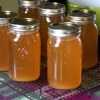
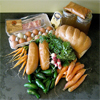
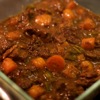

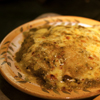
Where’s the recipe??
We’re experiencing some technical difficulties — our blog server is running painfully slow, and it was all we could manage to get this post up in time for the Dark Days roundup before running off to not one but two holiday parties this evening. If you’re interested in Cameron’s recipe for the Beef Braised in Ale, check back early next week.
Beef in Ale
– adapted from The River Cottage Meat Book
3# boneless chuck or stewing beef, trimmed and cut into 2-inch chunks
8 ounces pancetta or bacon, cut into 1-inch pieces
2 T butter or drippings
1 pound of onions (Hugh specifies baby onions, peeled and left whole. I used medium-sized yellow onions, quartered)
Up to 1/3 c all-purpose flour, seasoned with salt and pepper
4 cups ale (Hugh calls for stout)
2 bay leaves
1 sprig thyme
A few stems of parsley
8 ounces each of carrots and celery, cut into chunks
Heat the butter or drippings in a Dutch oven or other large stew pot and render the pancetta or bacon over medium heat, cooking until well-browned. Remove the bacon with tongs or slotted spoon and reserve on a plate. Fry the onions in the hot fat until they are lightly browned all over. Remove the onions and add to the bacon on the reserve plate. Turn up the heat to medium-high or high depending on your stove. Toss the beef in the seasoned flour and shake/pat off as much of the excess as possible, leaving only a fine layer of flour behind.
Working in batches, thoroughly brown the beef on all sides, removing it to the reserve plate when you dare not leave it in any longer. Here is where your diligence in flour removal will pay off. The browner you can make the beef chunks, the better your stew will taste, but extra flour will flake off and burn before you can get the beef where you want it.
Pour in some of the ale and deglaze the pot, scraping up the browned bits with a wooden spoon. Tip the contents of the reserve plate (bacon, onion, beef, and any juices that have collected) into the pot. Pour in the rest of the ale, adding water if necessary to just cover the meat. Add the herbs, tied into a bouquet garni. Taste and season lightly with salt and pepper, keeping in mind the saltiness of your bacon and the fact that you will be reducing the liquid. Bring to a boil and set to simmer gently with the lid on but slightly ajar.
The stew will need to cook roughly 2-1/2 hours. This can be done either on the stovetop or in an oven set to 250° F. If the meat starts to get exposed, add a little hot water. Approximately one hour before you expect the meat to be done, add the carrots and celery. You’ll know it’s done when the meat falls apart at the touch of a fork.
Remove the bouquet garni. Taste again for seasoning and serve under, over, beside, or puddled in potatoes that have been mashed with scandalous amounts of cream and butter.
Dark Days challenge, garden, locavore, recipes
8 Comments »




Posted by Anita on 11.30.08 11:26 AM
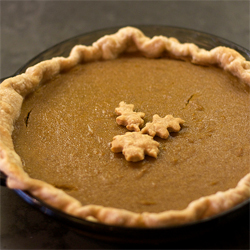 Apparently, I am not equipped to exist on 5 hours of sleep every night for an entire month, which is what happens when you try to hold down a job, tackle a little freelance work, keep a house in order, cook most meals at home, and blog every single night. But even though I failed at NaBloPoMo, I really did have a blast trying to keep my head above water. Despite the blog-silence, our week has been filled with all kinds of wonderful things to eat and drink… fodder for future posts, I promise, as we return to a slightly saner schedule in December.
Apparently, I am not equipped to exist on 5 hours of sleep every night for an entire month, which is what happens when you try to hold down a job, tackle a little freelance work, keep a house in order, cook most meals at home, and blog every single night. But even though I failed at NaBloPoMo, I really did have a blast trying to keep my head above water. Despite the blog-silence, our week has been filled with all kinds of wonderful things to eat and drink… fodder for future posts, I promise, as we return to a slightly saner schedule in December.
The highlight of our week — like many of yours, I suspect — was our big Thursday feast for Thanksgiving. This year, we managed to wiggle out of all of our family obligations, so it was just the two of us: No marshmallow-topped baked yams or gelatinous cranberry sauce (nor any of the other stuff neither of us likes) and no giant spreadsheet to track food miles. We still ate 100% local, but with a much smaller, simpler menu, we didn’t need to document with such precision.
I picked up our turkey — a burlap-wrapped 18-pounder from Napa’s Hudson Ranch, sold to us by Tayor at the Fatted Calf — at the Tuesday Berkeley Farmers Market. This squat little guy was so muscular we didn’t even need to truss the legs to keep them tight against the carcass. Although all we did was salt it the night before and slather it in butter, describing its taste sounds like a cliché: Moist and tender, yet full of deep poultry flavor. And the rich drippings made some of the most delicious gravy we’ve ever had.
 To go with the amazing turkey and gravy, we peeled and mashed many pounds of creamy La Ratte spuds from Mr. Little, mixed with butter from Spring Hill and Straus Family cream. Stuffing was the usual family recipe, with Fatted Calf bacon, Eatwell celery and parsley, Catalán onions, Acme bread, and our own home-grown sage and home-made chicken stock. There was corn from The Peach Farm — which I zipped and froze a few weeks back — and a bottle of Five Russians Pinot Noir from Sonoma. For dessert: Pumpkin pie made from local organic pumpkin, eggs, and dairy, in a crust of local flour (a blend of Eatwell and Giusto’s), Clover Organic butter, and Prather leaf-lard.
To go with the amazing turkey and gravy, we peeled and mashed many pounds of creamy La Ratte spuds from Mr. Little, mixed with butter from Spring Hill and Straus Family cream. Stuffing was the usual family recipe, with Fatted Calf bacon, Eatwell celery and parsley, Catalán onions, Acme bread, and our own home-grown sage and home-made chicken stock. There was corn from The Peach Farm — which I zipped and froze a few weeks back — and a bottle of Five Russians Pinot Noir from Sonoma. For dessert: Pumpkin pie made from local organic pumpkin, eggs, and dairy, in a crust of local flour (a blend of Eatwell and Giusto’s), Clover Organic butter, and Prather leaf-lard.
With only two of us to tackle a family-sized turkey, we cut off a whole breast, leg, and thigh, and vacuum-sealed them for the freezer; somewhere down the line there’s another round of turkey dinner (and leftovers!) in our future… what a way to stock up for winter!
The rest of our luxurious long weekend, we’ve spent tackling other Dark Days-related projects. Cameron’s been hard at work on building and filling our new raised beds, and we may even get a few starter crops in the ground before the new year. I’ve been pickling and preserving — a few quarts of chicken stock and turkey broth, some pickled jalapeños, and a batch of pub onions. After the canners were put away, I reorganized our freezers in preparation for laying down a few last supplies for the winter.
This week’s trip to the farmers market was pretty light, since we’ll mostly be eating an assortment of yummy bits and pieces from deep storage. Although a week of freezer fare may sound rather dreary, after four days of nonstop cooking and turkey leftovers, I’m really looking forward to a few meals where the hardest part is defrosting the main dish and making a big salad.
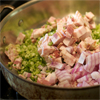


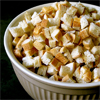
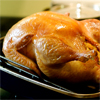
This year, I am especially thankful for:
– My wonderful husband, who takes care of me and our home with such obvious affection.
– Our family, who understand our need to take a break from the festivities now and then.
– Our social circle, whose hospitality and friendship keep us sane and happy.
– Our readers and blog pals, who encourage us and inspire us.
– Our amazing City, where we count ourselves lucky to live every day.
– Our region’s hard-working farmers and food artisans, who provide us with the world’s most amazing array of edibles.
Dark Days challenge, holidays & occasions, locavore, meat
6 Comments »




Posted by Anita on 11.23.08 11:55 PM
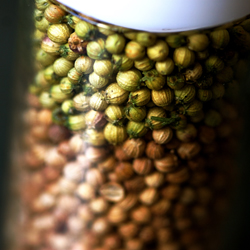 I was going to title this post “Last harvest”, but then I realized — even in our fairly seasonal garden — that our harvest never really ends. The lemon tree is ever-bearing, and is coming into its peak fruit-picking season. The bergamot is busting out all over; it dropped a fruit today — which is almost certainly hollow, but plenty good for making one of our favorite liqueurs.
I was going to title this post “Last harvest”, but then I realized — even in our fairly seasonal garden — that our harvest never really ends. The lemon tree is ever-bearing, and is coming into its peak fruit-picking season. The bergamot is busting out all over; it dropped a fruit today — which is almost certainly hollow, but plenty good for making one of our favorite liqueurs.
Our makrut (kaffir lime) tree is growing so large that it needs a fairly major pruning; when that happens, we’ll have enough aromatic leaves and fruit to supply a small Thai village. And although the lemon verbena is dying back to its canes, the plum tree has gone dormant, and the basil is long-since gone to seed, we’ll have most of our herbs — thyme, oregano, and sage — through the dark days.
Today we tackled two garden-related tasks: One in the kitchen, to put up a few bits of the 2008 season, and one at the lumber yard, to lay the ground work for 2009. Early in the day, I picked and sifted through piles of coriander and fennel seed, which I’d set aside a few weeks ago to dry. As you can see from the photo above, the color contrast between home-grown seeds — even when fully dry — and store-bought is fairly dramatic; the scent and flavor are even more astounding.
Later in the afternoon, we headed off to the suburbs in search of redwood decking. We’ve finally decided — after two years of avoiding reality — that our pretty patio is a luxury; even in our sunny ‘hood, we aren’t able to entertain outdoors more than a few times a year. So Cameron pulled out the gardening books, mapping out a plan to replace some of the slate pavers with raised garden beds. (I’m hoping he’ll pop by soon to tell you more about his construction plans and maybe even share his planting diagrams.)





Dark Days challenge, garden, locavore
7 Comments »




Posted by Anita on 11.16.08 10:44 PM
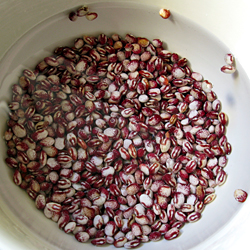 The irony of yesterday’s 80-degree excursion to the Ferry Plaza was that none of us wanted summery stuff. We waltzed right past stalls filled with tomatoes, artichokes, and strawberries(!) and gravitated toward the pork, beans, and greens we all craved despite the heat.
The irony of yesterday’s 80-degree excursion to the Ferry Plaza was that none of us wanted summery stuff. We waltzed right past stalls filled with tomatoes, artichokes, and strawberries(!) and gravitated toward the pork, beans, and greens we all craved despite the heat.
With the unseasonably warm weather and our un-air-conditoned house, we knew it would stay too hot to braise, so we headed over to the Marin Sun Farms stand and checked out their grillable options. Laura picked out a lovely slab of pork ribs, and I walked across the aisle for a bag full of Brussels sprouts from the Iacopi’s stand.
Since Laura’s only able to find pintos and cranberry beans at her local markets, she planned to load up her bag with lots of fun varieties from the Rancho Gordo stand. Little did we know that Steve Sando himself would be tending the stall on Saturday, training two new employees and charming the shoppers who were surprised to see the bean guru himself behind the baskets and bags. In addition to the four varieties Laura chose — old favorites Yellow Eye and Calypso, plus two others that escape me Pebble and Anasazi — we also bought a pound of Red Nightfall, for our Dark Days dinner that night. I had no idea how we’d serve them, but I knew we could find inspiration flipping through our just-bought copy of Steve’s new book, Heirloom Beans.
Cameron gave the ribs a simple rub (salt, pepper, dried sage, and pasilla), and we planned to serve them with a mustard-and-vinegar sauce, so we looked for a simple recipe that would showcase the beans’ natural flavors. It didn’t take us long to find a dish that we all agreed sounded delicious: What’s not to love about porky goodness topped with a drizzle of bright olive oil and a snowy dusting of cheese? We found a hunk of Fatted Calf pancetta in the freezer and snipped some fresh sage from the garden, swapped a red onion for yellow, and left out the original recipe’s carrot. The end result was delicious, if I do say so myself, and a perfect counterpoint to the smokiness of the ribs and the tart-bitterness of the shredded sprouts.
ps: For more great photos of our meal prep, don’t miss Laura’s set and post.
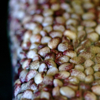

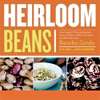
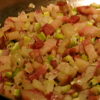
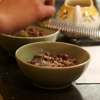
Beans with Pancetta and Sage
– adapted from Heirloom Beans
1/2 pound heirloom beans, soaked
– the original recipe calls for Jacob’s Cattle, but we used Red Nightfall
1/2 medium red onion, chopped
2 celery stalks, chopped
3 garlic cloves, minced
1/4 pound pancetta or slab bacon, diced
2T chopped fresh sage
dry Jack or other hard cheese, grated, for garnishing
Place the beans and their soaking liquid in a tall pot, adding enough cold water to cover by at least an inch. Bring to a boil for 5 minutes, then reduce heat to low. Simmer, partially covered, until beans begin to soften (about 30 minutes).
Meanwhile, heat a heavy skillet over medium heat. Add the olive oil and warm through, then add the onion, celery, garlic, pancetta, half of the sage, and a little salt and pepper. (Keep in mind your pork may be heavily salted.) Reduce heat to medium-low and sauté very slowly; do not allow the ingredients to brown. When very soft and aromatic, about 20 minutes, remove from heat and set aside.
Add the sauteed mixture to the beans and bring to a simmer, adding more water as needed. Taste the simmering liquid, and adjust for salt as needed. Simmer, partially covered, until the beans are tender, about another hour, keeping an eye on the water level. When beans are cooked through and no longer chalky, add the remaining sage and adjust seasonings; simmer for 5 minutes.
Serve the beans with a little of their pot liquor in shallow bowls, drizzled with olive oil and sprinkled with the grated cheese.
—-
Disclaimer: Cameron and I are big fans of pretty much everything Steve Sando does; the three of us are friends from the olden days on various food boards, and we’ve been known to babysit his market stall on occasion. There’s no way to say that I’m not biased, but I still think that the book is fabulous: The recipes go well beyond the usual things you think of making with dried beans; the photography is stunning; and the graphic design is trademark Rancho Gordo, with bold typography, clean lines, lots of white space, and judicious use of bright accent colors.
Although I’ve only cooked once from it, at the price ($15 on Amazon) it seems like a bargain. It’s got a fun foreword by Thomas Keller (yes, Food Jesus is one of Steve’s fans, too), great front matter that covers everything from Rancho Gordo history to equipment notes, and recipes from some of our favorite restaurants — like Range‘s Cellini Bean Soup with Chard and Poached Eggs. I’m looking forward to exploring it in more depth, and I’d say that even if Steve wasn’t a pal.
cookbooks, Dark Days challenge, farmers markets, locavore, other blogs, recipes
6 Comments »




Posted by Anita on 11.15.08 11:46 PM
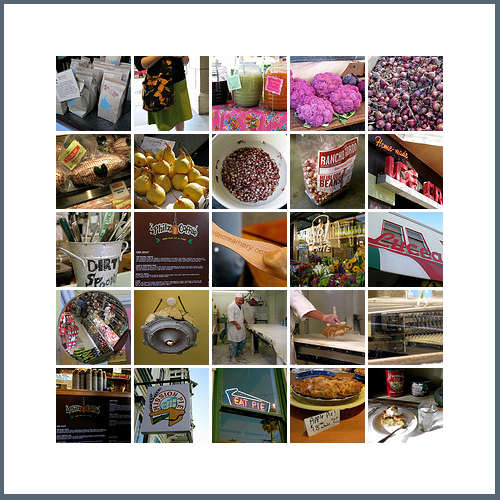
Oh, what fun we’re having with Laura, eating our way around the Ferry Plaza and The Mission from sunrise to sunset, then cooking up a storm for the first night of the Dark Days challenge. The three of us (with the dogs, naturally) sat up gabbing until almost midnight, telling stories and talking about… food, duh!
I promise a thorough recap later, but for now you can check out my Flickr set — plus Laura’s Flickr set and post on (not so) Urban Hennery — for a quick peek at our day.
Dark Days challenge, farmers markets, other blogs, shopping, The Mission
3 Comments »




Posted by Anita on 11.13.08 11:41 PM

…to Married with Dinner?
Laura from (not so) Urban Hennery is visiting San Francisco this weekend, and we’re the lucky ones who get to show her around! We’ve got a full schedule of foodie fun planned: Dinner at Range, a trip to the Ferry Plaza farmers market (of course!), even a stop at Mission Pie. And naturally we’ll hit some of the tourist highlights: The view from the top of Twin Peaks, a stroll through some of our favorite neighborhoods, and a drive across the Golden Gate Bridge.
We’ve even managed to stir up some mighty fine weather. Probably not quite as gorgeous as the autumn day in the photo above — that was October of last year — but it is supposed to reach the high 70s over the weekend, which is sure to send poor Laura home to the cold, dark, and rainy Pacific Northwest shaking her head.
As fun as our adventures will be, the part I’m most looking forward to is Saturday night, when we’re planning to cook dinner together with all the fun things we find at the market. We didn’t plan it this way (or maybe Laura did, ’cause she’s a organizer extraordinaire) but Saturday also happens to be the first day of this year’s Dark Days Eat Local Challenge.
Just like last year, we’ll make a point of searching out new local farmers and vendors — we’ll try to do a better job of profiling them, rather than just a quick mention — and cook at least one meal each week from 100% from our 100-mile radius. We’re going to pass on taking any exemptions other than salt and spices this time, since it’s just one meal a week, and we’ve got a pretty good assortment of just about every other class of food.

Our personal ground rules for the 2008/2009 Dark Days Eat Local Challenge:
- We will continue to cook 90-95% local as often as we can, with a challenge baseline of one dinner per week made from 100% local ingredients.
- We will write about new pantry items, new farmers we’ve discovered, and recipes for in-season items within our foodshed.
- Local for us will be a 100-mile radius. Strong preference will be given to items purchased directly from farmers at market rather than retail.Â
- For our weekly challenge meal, we’ll try to eliminate processed and prepared foods; We’re making ‘Marco Polo’ exemptions only for salt and seasonings.
- We’ll continue with the challenge through March 15, 2009.
Dark Days challenge, other blogs
4 Comments »




 When you live on an island that’s a mere 300 miles wide, local food is a relative thing. In the map to the left, the blue pin shows the location of our London flat. The green circle — which touches the Normandy coast of France — shows a 100-mile radius; yellow encompasses 150 miles, and blue — which grazes Paris! — illustrates the 200-mile radius that many wintertime eat-local challenges allow.
When you live on an island that’s a mere 300 miles wide, local food is a relative thing. In the map to the left, the blue pin shows the location of our London flat. The green circle — which touches the Normandy coast of France — shows a 100-mile radius; yellow encompasses 150 miles, and blue — which grazes Paris! — illustrates the 200-mile radius that many wintertime eat-local challenges allow. If you’re willing to leave the foodie haunts and supermarkets behind, the news gets better. FARMA-certified London Farmers’ Markets have some of the most thorough guidelines I’ve ever seen, touching on everything from permissible ingredients in artisan goods to animal welfare to to maximum distances traveled: Everything sold must be “raised, grown, produced, gathered, caught, or baked within 100 miles of the M25”, London’s exterior beltway. Even on a very slow week at the Marylebone Farmers Market, we were able to cobble together a full meal: Sausages (produced on Food Fore Thought‘s East Sussex farm, using their own-raised pork), Brussels sprouts, and potatoes, which we served with a store-bought bottle of real ale from Hook Norton in Oxfordshire, 81 miles from London.
If you’re willing to leave the foodie haunts and supermarkets behind, the news gets better. FARMA-certified London Farmers’ Markets have some of the most thorough guidelines I’ve ever seen, touching on everything from permissible ingredients in artisan goods to animal welfare to to maximum distances traveled: Everything sold must be “raised, grown, produced, gathered, caught, or baked within 100 miles of the M25”, London’s exterior beltway. Even on a very slow week at the Marylebone Farmers Market, we were able to cobble together a full meal: Sausages (produced on Food Fore Thought‘s East Sussex farm, using their own-raised pork), Brussels sprouts, and potatoes, which we served with a store-bought bottle of real ale from Hook Norton in Oxfordshire, 81 miles from London.




















 Between finishing up our Christmas shopping, getting
Between finishing up our Christmas shopping, getting 
























